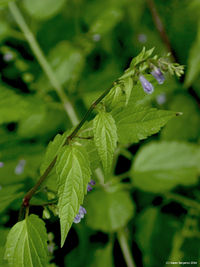Scutellaria lateriflora
| See Also | Botanical Monographs |
|---|
Skullcap (Scutellaria lateriflora) is known for its use in treating nervous tension, exhaustion and hysteria. To explore the characteristics, medicinal uses and prescribing considerations of this herb in more detail, check out the references indicated. [1] [2]
Contents
Characteristics
- Common Names: Skullcap, Helmet flower, Hoodwort, Quaker bonnet, Mad-dog skullcap, European or greater skullcap
- Family: Lamiaceae
- Habitat: Scutellaria lateriflora can been found in damp stream banks in eastern North America.
- Parts Used: Aerial parts during flowering, leaf and flower preferred (25% alcohol)
- Constituents: Flavonoids, volatile oils, iridoids, tannins
- Medicinal Actions: nervine tonic, antispasmodic, anticonvulsant, analgesic, antiallergic, anti-inflammatory gastrointestinal, sedative
Uses
Historical Uses:
Scutellaria lateriflora was used by the Native people of North America for ailments associated with menstruation and breast pain. In the 19th century, herbalists used it to treat hysteria, epilepsy, convulsions, schizophrenia, and even rabies. In general, Scutellaria lateriflora has been known for its use in treating nervous tension, exhaustion, spasm, and hysteria.
Medicinal Uses:
- Nerve Tonic
- nervousness from illness; mental or physical exhaustion
- headache from exhaustion
- delirium tremens
- petit and grand mal seizures, chorea or other tremors, neuralgia
- insomnia due to restlessness, mental exhaustion and overwork
- heart disease associated with nervousness, irregular arrhythmias, or intermittent pulses
- circulatory problems such as stroke, emboli or thrombi, used for paralysis or insomnia associated with stroke
- muscular fasciculations (e.g., eye twitches, striated muscles), especially when nervous; may have difficulty controlling even major muscles in exhausted state
- uterine problems due to nervousness or excitability plus muscular spasm
- exhaustion associated with chronic disease (severe influenza or pneumonia), residual exhaustion
- teething in children (trouble sleeping, anxious); good substitute for chamomile but not as pleasant.
Prescribing Considerations
The information provided is intended to augment the treatment from a naturopathic doctor or other trained medical professional. Although most herbs are generally safe, it is recommended that you avoid self-prescribing especially when there is an underlying ongoing medical condition, if you are on any prescription medications or if you are pregnant or breastfeeding.
Formulations and Preparation
- Tincture - 10-60 drops three times daily
- Fluid extract - 5-30 drops three times daily
- Powder - 5-30 drops daily
- Infusion - 1-3 cups daily, 3-6 cups daily short term using 1-2g of herb
Safety
The safety and prescribing considerations for this herb include:[3], [4]
- Generally regarded as safe.
- Side-effects are drowsiness, giddiness, confusion, convulsions (in large doses), hepatoxicity (may be due to adulteration of products with germander).
- Cautions and Contraindications: pregnancy and lactation
- Drug-Herb Interactions are not known. Caution should be taken in patients taking other centrally acting drugs.[1]
References
- ↑ 1.0 1.1 Boon Heather, Smith Michael 2009 55 Most Common Medicinal Herbs: The Complete Natural Medicine GuideSecond Edition Institute of Naturopathic Education and Research, CCNM Toronto.
- ↑ Godfrey Anthony, Saunders Paul, Barlow Kerry, Gowan Matt. 2011 Principles and Practices of Naturopathic Botanical Medicine, Advanced Botanical Medicine. V3 CCNM Press, Toronto
- ↑ Stargrove Mitchell Bebell, Treasure Jonathan, McKee Dwight L (2008) Herb, Nutrient and Drug Interactions: Clinical Implications and Therapeutic Strategies
- ↑ Brinker Francis (1997) Herbal Contraindications and Drug Interactions: Plus Herbal Adjuncts With Medicines, 4th Edition Eclectic Medical Publications.
